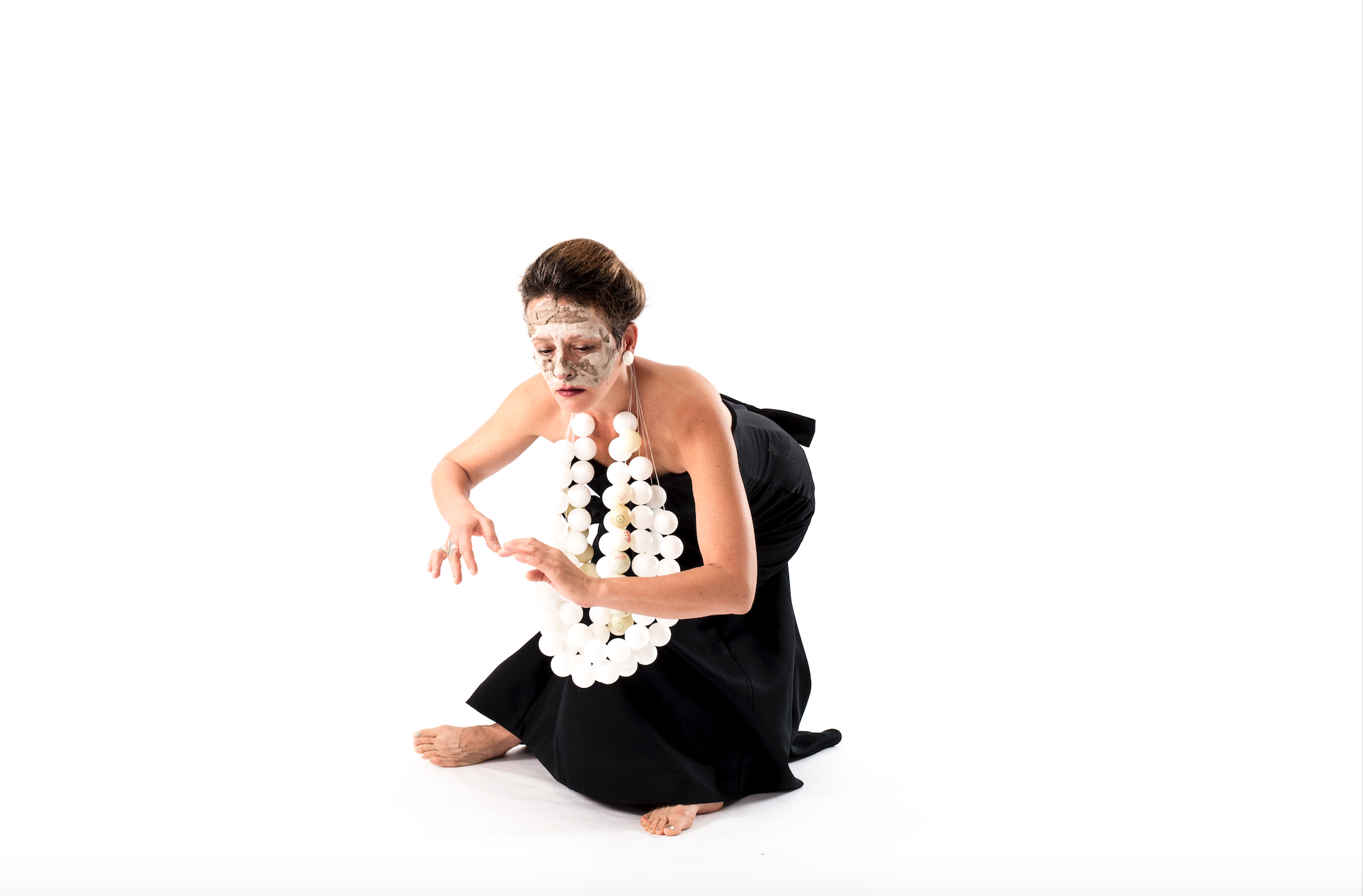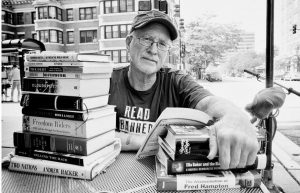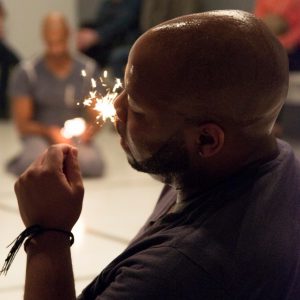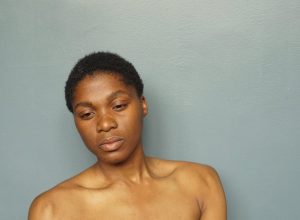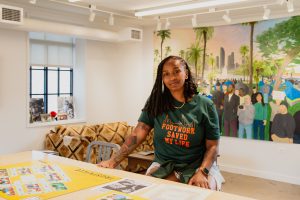Movement Matters investigates work at the intersection of dance, performance, politics, policy and issues related to the body as the locus of these and related socio-cultural dialogues on race, gender, ability and more. For this installment, we sit down with dancer and performance artist Carole McCurdy to discuss the pleasures of dancing blind, ageism and starting as a dancer after the age of 40 in a field conceived of as a younger person’s art by the popular culture.
Michael Workman: You’re from the north side of Chicago.
Carole McCurdy: Yes, I grew up in East Rogers Park, and that’s where I live now. I love it because the lake’s at my doorstep. I swam practically every day in August! I lived in New York City from 1984 to 2003, moved back to take care of my mother just before she died, and ended up staying here. I have a fond nostalgia for my days in the East Village and miss my East Coast friends, but Chicago offered me life-changing opportunities that have been so gratifying. I can’t imagine leaving it anytime soon. Well, except for the winter, when I’ll head to South America.
MW: How did you initially get interested in dance? As an artist or in terms of doing it professionally?
CM: Through social dancing. Almost twenty years ago I fell into the embrace of Argentine tango, and it thrilled and challenged me on so many levels. You’re creating a circle with a partner and a circular path through time and space, and every time you go around the dance floor it’s “same-same but different.” It’s infused with nostalgia but also totally immediate, improvised moment by moment. Over the years I’ve spent many months in Buenos Aires tracing those circles. Before tango, I was hunched over manuscripts, working as a copy editor for book publishers in New York, lost in my head and with all kinds of crunk in my neck and shoulders. For a geek like me, dancing in the structured environment of tango was a great way to reenter the physical world. Humbling and humiliating at times, but it slowly turned me into a maker through movement. I started exploring butoh about twelve years ago, and it jolted me into ways of thinking about embodiment that went beyond social constructs and into the primal and metaphysical. I learned that physical limitations (well, I guess I’m talking about my own not-so-neurotypical movement traits) could be mined as an asset artistically. I started performing and making pieces, and eventually had to start calling myself an artist. That took some getting used to.
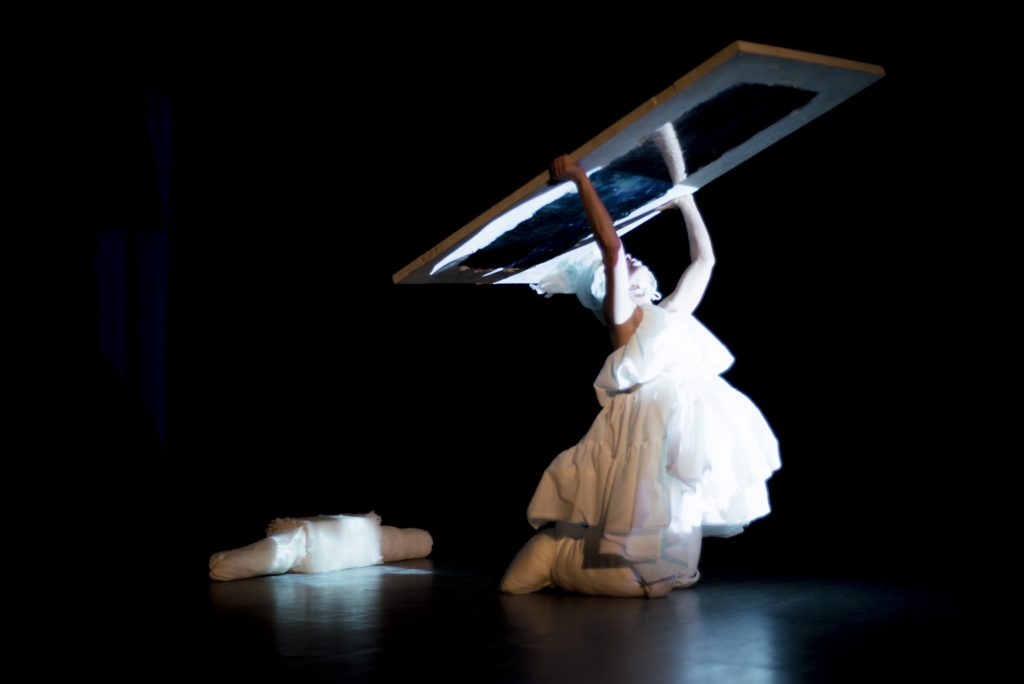
MW: Who were the people that most influenced your work in dance?
CM: I took my first butoh classes with Nicole LeGette in Chicago after moving back here from New York, and I imprinted on her like a duckling. In less than a year she had me performing in her pieces. That gave me so much–the confidence to work through the challenges she set, examples of processes for composing work, and in those classes and ensemble pieces I met so many people that I continue to collaborate with and learn from. [They’re] the artistic friendships that make my world. Having a teacher and mentor who was younger than me was a lucky way to get started. While getting a lot of rigorous training, I could watch Nicole’s artistic ideas ripening, and that gave me courage to start developing my own ideas and follow my own instincts. Improvising on solo pieces, often at one-time underground events, gave me the chance to experiment and develop a sense of myself as a performer. Now I’m working on a project where I’m aiming for the rigor and contrariness of butoh while taking inspiration from the partner dynamics of tango. It’s crazy. We’ll see [how it goes].
MW: Describe the where you’d like to go with your work from here.
CM: If I could use sentences to articulate the things I want to project into the audience, I’d be writing essays and not dancing. Saying that is not only a dancerly dodge, but very much in the tradition of butoh, a form that arose in Japan after WWII in a time of shock, mourning, and cultural protest. One of the hallmarks of butoh, which has has branched out beyond Japan as a dance subculture, is that it constantly recontextualizes itself, always challenging our understandings of the body in time and space. When it works, the effect is uncanny and transformative. When it fails, it’s merely maudlin or comical. I’m proud of my sad and amusing failures, for sure, but I hope that some moments of my butoh-influenced work have messed with somebody’s head.
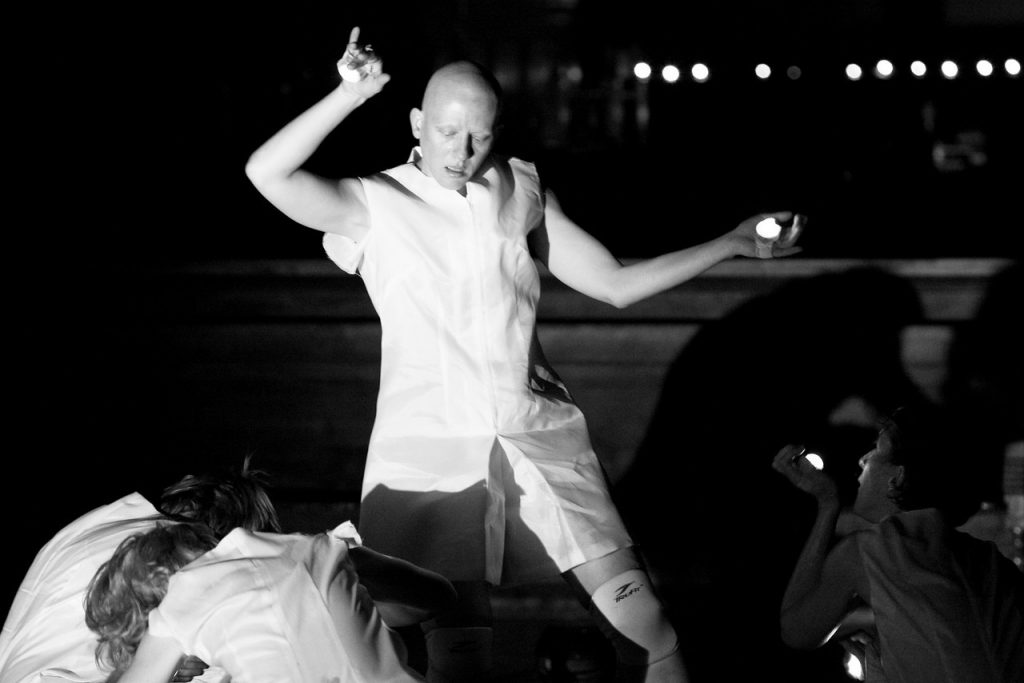
MW: How do you think what you’re working on now in your residency at High Concept Labs and elsewhere will change what your doing?
CM: My new project, Waver, is still early gestating and although I’m working with influences from butoh and tango, the result probably won’t feel quite like either. Nor do I want to make a hybrid. A strange beast with hints of the familiar: that would satisfy me.
MW: What do you feel like have been your most successful artistic aspirations?
CM: Maybe it’s perverse, but I’d rather not dwell on aspirations. For initiating anything, they’re necessary, but then you start working and everything’s real and grounded and honestly unwieldy. Performances that worked best for me have come from “embrace the accident.” For example, I recently did a solo improvisation piece at New Room, an informal event curated by April Noga and Eli Halpern: it was barely rehearsed and involved a wig that concealed my face. When I tried it at home I could see through the wig well enough, I thought. At the performance I couldn’t see anything and had to feel my way around: a wonderful vulnerability and new information to play with. I was delighted to build on it, and it literally connected me with the audience. Yes! But what I’m starting to learn to avoid (and it’s a mistake I’ve made a few times) is overloading a piece with too many elements. I have to resist the oversolicitous tendency to dump out the box and share every toy.
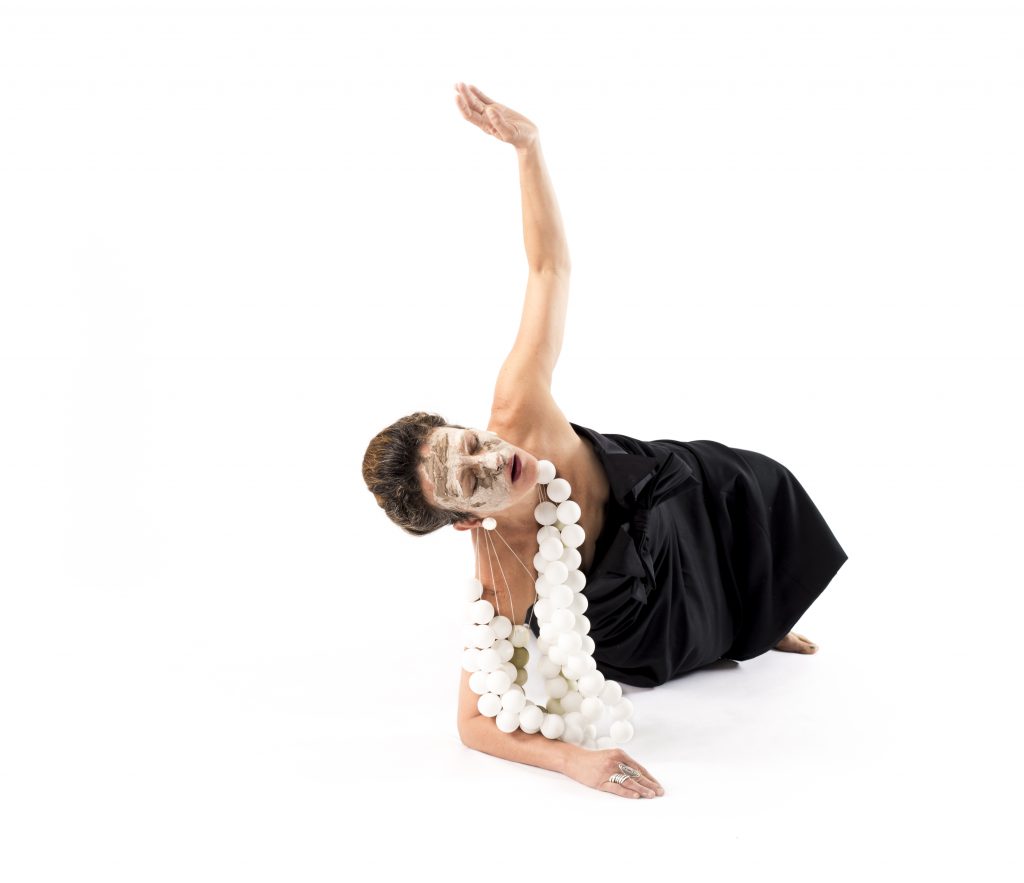
MW: As an artist who is a late bloomer to dance, what do you feel are the resistances you face in our often ageist culture?
CM: Ha, I was just thinking about having used the word nostalgia twice already here. Dance is made by the body in space and time, and as someone who started performing and making dance after the age of forty I’ve gotten to offer a fresh perspective on that. One of the simple movement scores I revisit is a thing I call Slow Hurry. Struggling with time is the one place I’ve always been. My friends know I’m usually late for appointments, and they suffer with me. It’s a moral failure or a social abuse, I guess, but until I’m rehabilitated the inexact connection fascinates me. Stepping onto the stage late means “doing it wrong” in a way that opens a new frame. Some of my pieces have looked overtly at aging, illness, and mortality (after treatment for two kinds of cancer, that became a part of my material). I could make a conscious effort to stick to those subjects, but I think I can count on them to be present while I look at other things! Fortunately my training is in two dance fields that revere the aging dancer and work with time in complex ways. In Buenos Aires there are ninety-year-olds out on the dance floor showing young tangueros how it’s done. And Kazuo Ohno, who along with Tatsumi Hijikata brought butoh into the world, danced until he died at 103. No question that American dominant culture values youth over age, but here’s a late bloomer who found audience and support thanks to Links Hall, Chicago Dancemakers Forum, High Concept Labs, and a bunch of young artists out of SAIC. Whoa: dance as a survivor institution quite generously offered space for me. But outside of music videos, dance itself is as marginalized as a “sweet little old lady.” So where I see the need to push back and find change is at the level of dominant culture. One way I can help make those changes happen: keep dancing.
Please feel free to send questions, comments or tips to Michael Workman at michael.workman1@gmail.com. Please join the Movement Matters Facebook page for updates, and to join in on future online conversations.
Featured Image: Carole McCurdy. Photo by Benjamin Wardell Studios.
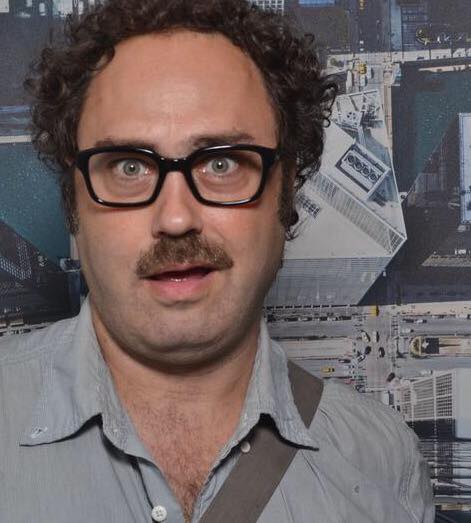 Michael Workman is an artist, writer, dance, performance art and sociocultural critic, theorist, dramaturge, choreographer, reporter, poet, novelist and curator of numerous art, literary and theatrical productions over the years. In addition to his work at The Guardian US, Newcity, Sixty and elsewhere, Workman has also served as a reporter for WBEZ Chicago Public Radio, and as Chicago correspondent for Italian art magazine Flash Art. He is also Director of Bridge, a Chicago-based 501 c (3) publishing and programming organization. You can follow his daily antics on Facebook.
Michael Workman is an artist, writer, dance, performance art and sociocultural critic, theorist, dramaturge, choreographer, reporter, poet, novelist and curator of numerous art, literary and theatrical productions over the years. In addition to his work at The Guardian US, Newcity, Sixty and elsewhere, Workman has also served as a reporter for WBEZ Chicago Public Radio, and as Chicago correspondent for Italian art magazine Flash Art. He is also Director of Bridge, a Chicago-based 501 c (3) publishing and programming organization. You can follow his daily antics on Facebook.
